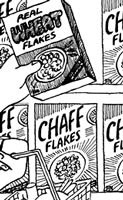No escape from reality
Even self-confessed technophobe Richard Murray can see advantages in a virtual world, though he maintains it’s no substitute for things that are real.

Isn’t it fascinating that as our lives become increasingly virtual we are embracing, or clinging on to products and services which can only be described as, well, “real”.
For me a real thing is something which provides a much needed antidote to our fleeting and frivolous consumer society. More than being simply nice to have, a real thing can enhance your life in some small way. It allows the individual to attach a personal value to something when seemingly fewer and fewer things offer any real sense of worth.
A real thing can be virtually anything, from a Zippo lighter to a Dualit toaster, or a Roberts radio. Heinz Ketchup (in a glass bottle), Maldon sea salt, or a Kelly Bronze turkey at Christmas. But do not get confused – it’s not about nostalgia, for I would classify the Dyson cleaner, the i-Mac, and the Sony Walkman as real things, too. Neither is it about discernment and trading up (as those trends belong to the 1980s and 1990s), nor is it about making a designer statement.
It is simply about taking great pleasure from things that come with an inherent integrity offer. Things that perform a function properly and, usually, better than their competitors. It is essentially about separating substance from style.
The millennium consumers love of real things is everywhere: as a nation we are unblocking the fireplaces to enjoy naked flames; peeling back the carpets to reveal the beauty of wooden floors; and visiting the reclamation yards. Gardening is no longer the domain of the middle-aged. It is a way to connect with real living things – a way to get your hands dirty after a hard day on the mouse. And please remember that these trends are in no way confined to the Soho microcosm!
We’re cooking again – having endured decades of convenience and prepared foods we seem to want food that looks and tastes of real food, and we are happy to cook it ourselves thanks to Delia Smith and co. An enthusiastic cook back in the 1970s would have owned a Sodastream, in the 1980s they would have a multifunction Magimix. Today’s counterpart possesses a little metal saucepan to fry their eggs properly.
If dining out in London you’ll have witnessed the resurgence of Langans, Simpsons, and the Savoy Grill as the places to go. The steady diet of Conran eateries and their various imitators over recent years, while undoubtedly fueling interest in food per se, ultimately seems to have led to rocket and parmesan fatigue.
So what impact does a return to real things have in terms of what we do as brand designers? Primarily, it acts as a sobering reminder that you can’t pull the wool over the consumers’ eyes – no matter how daft you may think they are (such is their new found level of sophistication that they may question the authenticity of the “wool” claim!). Your target may well be a C2 housewife, but she will be able to sniff out that the Norfolk Casserole sauce has about as much to do with Norfolk as Italian style suits have with Italy. Fact – the millennium consumer is increasingly able to detect when a marketing concept camouflages a disappointing product truth.
I hope that the awakening consumer conscience could actually be good news for design standards. As people begin to look at what is important in their life, might gratuitous or thoughtless brand design find itself thrown to one side? Will the consumer effectively begin to sort the wheat from the chaff on behalf of the client organisations and the design industry? After all, if it’s not real why should I buy it?
This then begs the question, what design trends might we expect to see as consumers pursue real brands? If the 1980s was about style, and the 1990s about pastiche and parody, I sense we might be about to see the significance of function and form over the next decade. Mere decoration and transient graphics (trying desperately to capture the moment every two years) will simply not impress. Packaging design will be about persuading consumers that a brand is legitimate and a pleasure to use.
Although I admit to being a technophobe, I have to confess that as we move into the new millennium, I can see the plus side of the virtual world. Above all a growing acceptance of comfort with technology allows us to take stock of our lives and prioritise the things that really matter and help to create a better sense of balance.
-
Post a comment



